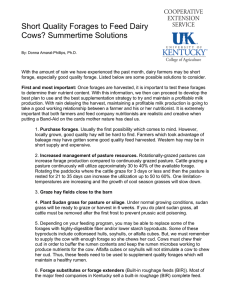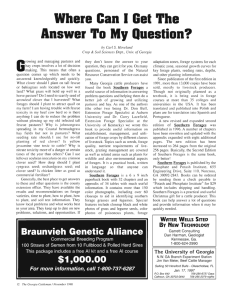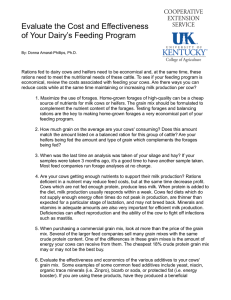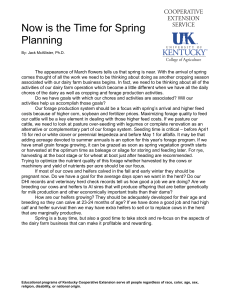Developing Plans to Deal with Late Harvested Forages
advertisement
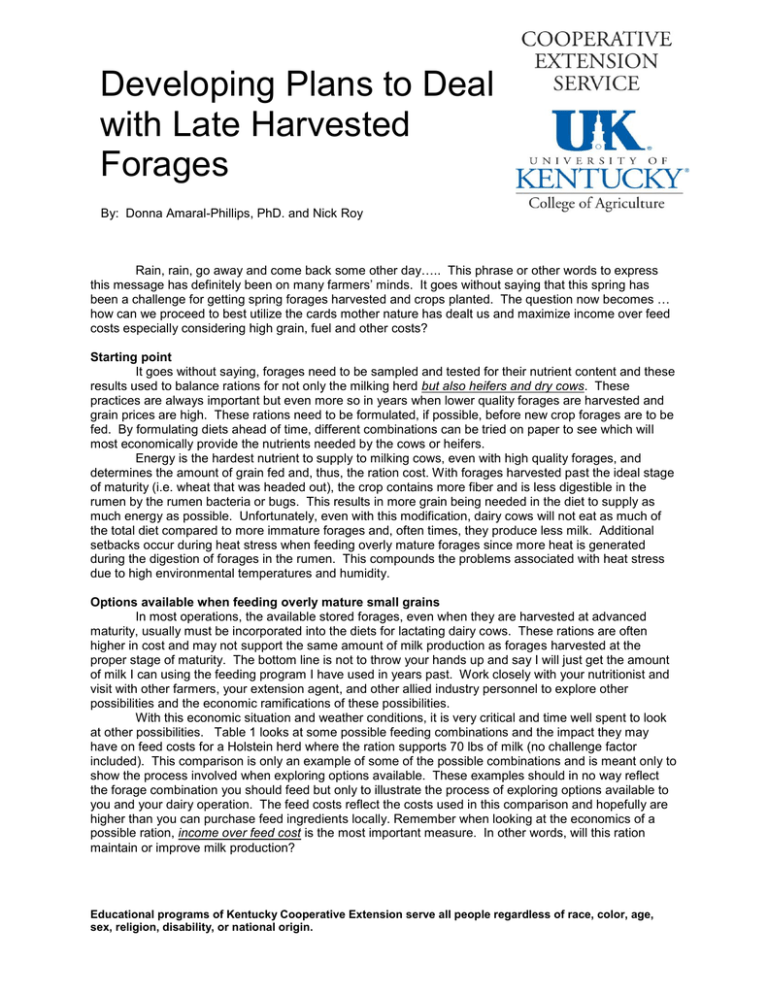
Developing Plans to Deal with Late Harvested Forages By: Donna Amaral-Phillips, PhD. and Nick Roy Rain, rain, go away and come back some other day….. This phrase or other words to express this message has definitely been on many farmers’ minds. It goes without saying that this spring has been a challenge for getting spring forages harvested and crops planted. The question now becomes … how can we proceed to best utilize the cards mother nature has dealt us and maximize income over feed costs especially considering high grain, fuel and other costs? Starting point It goes without saying, forages need to be sampled and tested for their nutrient content and these results used to balance rations for not only the milking herd but also heifers and dry cows. These practices are always important but even more so in years when lower quality forages are harvested and grain prices are high. These rations need to be formulated, if possible, before new crop forages are to be fed. By formulating diets ahead of time, different combinations can be tried on paper to see which will most economically provide the nutrients needed by the cows or heifers. Energy is the hardest nutrient to supply to milking cows, even with high quality forages, and determines the amount of grain fed and, thus, the ration cost. With forages harvested past the ideal stage of maturity (i.e. wheat that was headed out), the crop contains more fiber and is less digestible in the rumen by the rumen bacteria or bugs. This results in more grain being needed in the diet to supply as much energy as possible. Unfortunately, even with this modification, dairy cows will not eat as much of the total diet compared to more immature forages and, often times, they produce less milk. Additional setbacks occur during heat stress when feeding overly mature forages since more heat is generated during the digestion of forages in the rumen. This compounds the problems associated with heat stress due to high environmental temperatures and humidity. Options available when feeding overly mature small grains In most operations, the available stored forages, even when they are harvested at advanced maturity, usually must be incorporated into the diets for lactating dairy cows. These rations are often higher in cost and may not support the same amount of milk production as forages harvested at the proper stage of maturity. The bottom line is not to throw your hands up and say I will just get the amount of milk I can using the feeding program I have used in years past. Work closely with your nutritionist and visit with other farmers, your extension agent, and other allied industry personnel to explore other possibilities and the economic ramifications of these possibilities. With this economic situation and weather conditions, it is very critical and time well spent to look at other possibilities. Table 1 looks at some possible feeding combinations and the impact they may have on feed costs for a Holstein herd where the ration supports 70 lbs of milk (no challenge factor included). This comparison is only an example of some of the possible combinations and is meant only to show the process involved when exploring options available. These examples should in no way reflect the forage combination you should feed but only to illustrate the process of exploring options available to you and your dairy operation. The feed costs reflect the costs used in this comparison and hopefully are higher than you can purchase feed ingredients locally. Remember when looking at the economics of a possible ration, income over feed cost is the most important measure. In other words, will this ration maintain or improve milk production? Educational programs of Kentucky Cooperative Extension serve all people regardless of race, color, age, sex, religion, disability, or national origin. Developing Plans to Deal with Late Harvested Forages Table 1. Effects of changing the forage make-up of rations formulated for Holsteins to support 70 lbs of milk. These rations are intended for comparison purposes and not to be fed. To determine potential ration combinations for your dairy herd, current forage analyzes and forage inventories should be used. Ration Number 1 2 29.4 7 24.2 3 4 (lbs as fed/day) 50 40 15 30 7 24.2 28.2 Corn Silage Wheat Silage Alfalfa Hay Grain Amount 50 20 70 Cost 27.8 55 5 25.9 $5.64 $5.52 $5.33 $5.25 $5.21 $5.33 5 30 40 6 Costs used for this comparison: Corn silage- $40/ton, Wheat silage - $25/ton, Alfalfa hay purchased (RFV 150)- $200/ton, Corn grain- $333/ton, Soybean meal- $450/ton, Soyhulls- $195/ton, Dried distillers grain- $285/ton, corn gluten feed- $200/ton. Cost of additives, minerals, and vitamins are not included but should be relatively constant between diets. Ways to Deal with Low Quality Forages Some possibilities may include (not in any particular order): 1. When possible, feed lower amounts of the later maturity forage (i.e. small grain baleage or silage) and increase the amount of corn silage fed. There is still time to divert acreage toward corn silage to increase tonnage placed in storage. Although not incorporated into ration balancing programs, we know from practical experience and in research trials that cows, especially early lactation cows (the money makers), will milk better when lower quality forages are removed from the diet. The forage will pass out of the rumen quicker and is more digestible, and, as a result, cows will eat better and milk more. 2. Purchase high quality alfalfa hay (RFV greater than 180) at a reasonable price. Table 2 looks at the relative feeding value of alfalfa hay when corn grain is available ground and mixed for $333/ton and soybean meal is $444/ton. Table 2. The relative feeding value of alfalfa hay as a replacement for a grain mixture assuming that ground corn grain is valued at $333/ton and soybean meal is $444/ton. Relative feed value Value*/ton Crude protein (%) ADF (%) NDF (%) 218 $335 23 24 30 200 $342 21 26 32 178 $314 19 28 35 152 $304 17 30 40 *Assumes a 5% feeding loss 3. Shop around for quality alfalfa hay. Table 3 illustrates the impact cost per ton of alfalfa hay on total feed cost per cow. Table 3. Effects of cost of alfalfa hay on overall ration cost. Alfalfa Hay Cost $150/ton $200/ton $250/ton $300/ton Total ration cost/cow/day when price of alfalfa hay varies Ration #2- 70 lbs corn silage, 7 lbs purchased alfalfa hay, 24.2 lbs grain $5.34 $5.52 $5.70 $5.87 (same as ration 2 in Table 1) Educational programs of Kentucky Cooperative Extension serve all people regardless of race, color, age, sex, religion, disability, or national origin. Developing Plans to Deal with Late Harvested Forages 4. Look at planting alternative annual crops for heifers and dry cows to spare higher quality forage for the milking herd. Forage sorghum can be planted later in the growing season and result in good yields for silage or grazing. Sorghum should be harvested after it reaches at least 18 inches in height and before it heads out. Brown midrib varieties of sorghum in contrast to regular varieties have lower lignin contents, are more digestible, and are recommended to be fed to high performance cattle, such as lactating dairy cows. 5. Group cows within the dairy herd and fed the best quality forages to the higher money makers— the early lactation or high producing cows. Later lactation cows are fed more forage and higher amounts of the lower quality forages. 6. Incorporate more grain (YUCK!!! $$$$) or fat supplements into the diet to supply more energy with low quality forages. These fats could include whole cottonseed (also not cheap), whole soybeans (no urea in the diet) or other ruminally inert fat sources. Dried distiller’s grains most often contain 8-12% crude fat so make sure to work with your nutritionist to provide adequate but not excessive amounts of different types of fats. 7. Replace some of the lower quality forage with commercially available forage extenders or forage/grain replacements to increase the energy density of the diet. Cautions In some parts of Kentucky, wheat scab has been detected. The fusarium mold that causes this plant disease can result in increased concentrations of mycotoxins in hay, silage, baleage or grain. Specifically, this disease causes increased concentrations of DON (deoxynivalenol or vomitoxin) and zearalenone. DON can decrease daily feed intake in dairy cows and depress the immune system. Zearalenone has estrogen- like properties and can cause poor reproductive performance and mammary gland enlargement of virgin heifers. If you suspect problems, the crop can be tested for the presence of mycotoxins. If suspected, the amount of the forage or grain will need to be reduced to decrease the amount of mycotoxin fed to these dairy cattle. Work with your veterinarian and nutritionist to calculate the best way to utilize this crop. Wheat scab also results in low test weight grains (less than 60 pounds of wheat grain per bushel) being harvested. These grains can be fed to dairy cattle as long as mycotoxin levels are not a problem. Low test weight grains do contain decreased concentrations of carbohydrates and, depending on the bushel test weight, energy content of the grains may need to be adjusted downward slightly. In general, grain mixes should contain no more than 30-50% wheat because of the quick rate at which wheat is fermented in the rumen and for the prevention of acidosis. In addition, wheat grain needs to be processed to assist digestion. Step back every so often and “smell the roses” With the multiple delays for spring field work and other stresses associated with dairy farms, understandably everyone is stressed more than usual. Please do not let these stresses get the best of you. Take some time to step back and regroup so that you can feel like you can deal with the challenges mother nature is giving and has given you. Take an hour and do something you enjoy. At a conference I attended recently, a dairy farmer was asked how she dealt with all the stresses associated with their dairy operation. I really appreciated her response and have tried to utilize her advice. Each day she thinks of something good that has happened that day. Try to think of the good things and accept the challenges that things do not always turn out the way we would like. We need to smell the roses in life. Educational programs of Kentucky Cooperative Extension serve all people regardless of race, color, age, sex, religion, disability, or national origin.

